 ECG technique
ECG technique
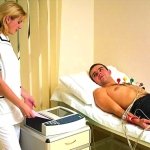
An important skill for a nurse is the correct technique for taking an ECG (electrocardiogram). Recall that electrocardiography is a technique for recording the electrical fields of the heart that arise in the course of its activity. as well as their receipt of their graphic image on paper or display. Electrocardiography is an informative and non-invasive method for studying the work of the heart - convenient and valuable for the patient and the attending physician.
An electrocardiogram is a graphic image in the form of a curve obtained during electrocardiography on paper or a display. ECG recording is carried out using devices - electrocardiographs. Any electrocardiograph has:
- input device;
- heart biopotential enhancer;
- recording device.
A nurse is allowed to work with an electrocardiograph only after training, best of all in the specialty " Functional Diagnostics ". ECG registration is carried out in a specially adapted and equipped room, as well as in the ward at the patient's bedside, at home, at the place of medical care, in an ambulance.
The ECG room must be kept away from any suspected sources of electrical interference. It is advisable to shield the couch: it is covered with a special blanket with a sewn-in grounded (!) metal mesh.
ECG removal technique: algorithm
Immediately before the planned ECG registration, the patient should not eat, smoke, drink stimulating drinks (tea, coffee, "energy"), or physically load the body.
We fix in the necessary documentation the personal data of the patient, the number of the medical history, the date and time of the ECG.
Place the patient on the couch in the supine position. We degrease those areas of the skin where we will apply the electrodes - we wipe them with a napkin moistened with an isotonic sodium chloride solution (0.9%).
We apply electrodes: 4 plate electrodes - on the lower thirds of the inner surface of the legs and forearms, and on the chest - chest electrodes equipped with pear suction cups. For single-channel recording, 1 chest electrode is used, for multi-channel recording, several.
We attach wires of a certain color coming from the electrocardiograph to each electrode. Common labeling of electrocardiograph wires:
- red - right hand;
- yellow - left hand;
- green - left leg;
- black - right leg (patient grounding);
- white - chest electrode.
When registering an ECG in 6 chest leads in the presence of a six-channel electrocardiograph, the following tip markings are used:
- red - for connection to the electrode V1;
- yellow - to V2;
- green to V3;
- brown - to V4;
- black - to V5;
- blue or purple - to V6.
Most often, an ECG is recorded in 12 leads:
- 3 standard (bipolar) leads (I, II, III);
- 3 reinforced unipolar leads;
- 6 chest leads.
Standard (bipolar) ECG leads
Registration of standard limb leads is carried out when the electrodes are connected in pairs:
- I standard lead - left hand (+) and right hand (-);
- II standard lead - left leg (+) and right arm (-);
- III standard lead - left leg (+) and left leg (-).
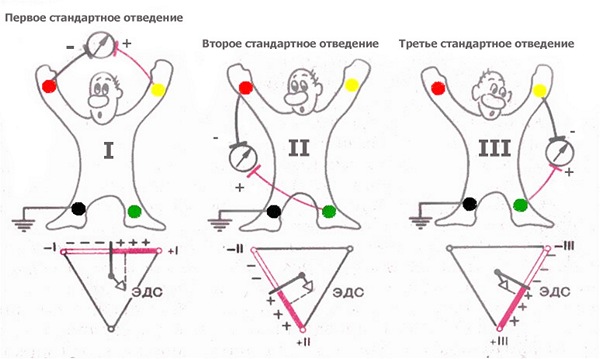
Formation of three standard electrocardiographic leads from the extremities. Below - Einthoven's triangle, each side of which is the axis of one or another standard lead
Amplified unipolar limb leads
Unipolar leads are characterized by the presence of only one active - positive - electrode, the negative electrode is indifferent and is a "combined Golberg electrode", which is formed when two limbs are connected through additional resistance.
Reinforced unipolar leads have the following designations:
- aVR - lead from the right hand;
- aVL - from the left hand;
- aVF - from the left leg.
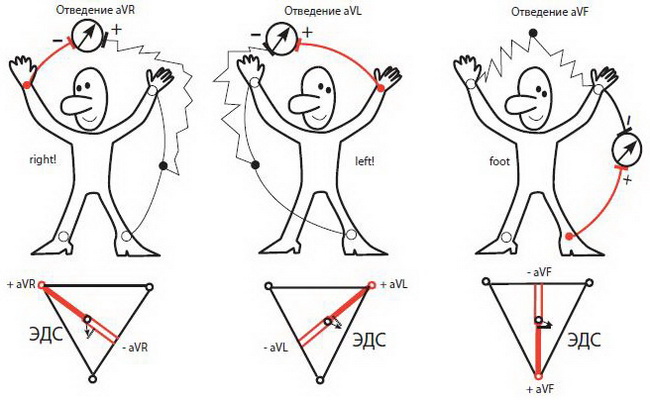
Formation of three reinforced unipolar limb leads. Below - Einthoven's triangle and the location of the axes of three reinforced unipolar limb leads.
chest leads
The chest leads in the ECG are unipolar. The active electrode is connected to the positive pole of the electrocardiograph, and the triple indifferent electrode united from the limbs is connected to the negative pole of the device. The chest leads are usually denoted by the letter V:
- V1 - the active electrode is placed in the IV intercostal space at the right edge of the sternum;
- V2 - in the IV intercostal space at the left edge of the sternum;
- V3 - between the IV and V intercostal spaces along the left parasternal line;
- V4 - in the V intercostal space along the left midclavicular line;
- V5 - in the V intercostal space along the anterior axillary line;
- V6 - and V intercostal space in the midaxillary line.
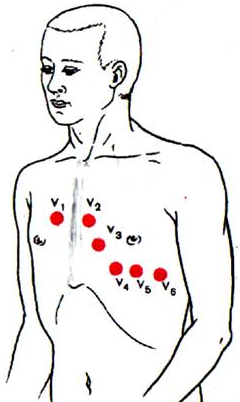
Choice of electrocardiograph gain
When selecting the amplification of each channel of the electrocardiograph, it is necessary that a voltage of 1 mV causes a deviation of the galvanometer and the recording system of 10 mm. In the position of the switch leads "0" adjust the amplification of the device and register the calibration millivolt. If the amplitude of the teeth is too large (1 mV = 5 mm), the gain can be reduced, if it is small (1 mV = 15-20 mm), it can be increased.
ECG registration
An electrocardiogram is recorded with the patient breathing calmly. First - in I, II, III standard leads, then - in enhanced unipolar limb leads (aVR, aVL, aVF), then - in chest leads V1. V2, V3, V4, V5, V6. In each of the leads, at least 4 cardiac cycles should be recorded.
As can be concluded from the presented, with the necessary knowledge and skills, the ECG recording technique should not present any difficulties for the nurse. We suggest watching a video on the topic to consolidate what you have read:
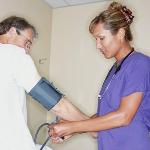
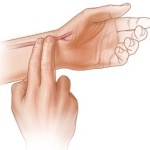
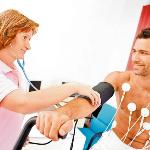
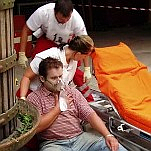
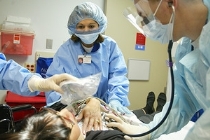
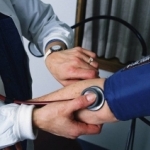
A bicycle ergometer is cheaper, takes up less space, and is less noisy than a treadmill. Also, when working on it, unlike the treadmill, the movements of the upper half of the body are less pronounced, which facilitates ECG recording and blood pressure control.
III standard lead: left arm (-), left leg (+)! Noooo????????